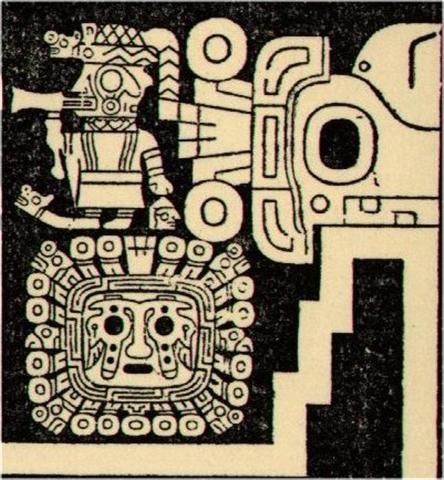2. Equally clear for everyone, at least it was so in ancient times, is the fact that Sun comes to a stand-still (i.e. 'he dies') twice a year, at the solstices. On the stone monument called The Gateway of the Sun at Tiahuanaco there is a detailed description of the 12 months of the year and this description is symmetric - the end where winter solstice is located looks exactly as the other end where summer solstice is (though the pictures are mirrored of course): 
A strange person is blowing his trumpet as if to call
attention, and from his other hand is dangling a decapitated
head. Below him is the Sun head for the month, which is
either June or December.
The head gear of the man with a trumpet is
connected to the crown of the Great Bird who is ascending at 'the
end of time', i.e. the man must be the same 'person' as this
great 'manu
rere' of Sun. Posnansky identified him with the 'king'
of the condors:
Primitive peoples who are, like all who live close to nature, extremely careful observers, tried to represent hierarchy and its various grades in the same way that they observed it among the animals. They noted the number of hierarchical degrees that existed among the latter and especially among the birds of prey. They observed the great respect and profound veneration showed by the condors to their leader, the 'Mayku' ... an ancient and venerable male condor whose head is adorned with an imposing crest; and this crest is, precisely, the origin of the crown in the ideology of the peoples of the Andes. These primitive peoples also observed that when a larger animal died in the field, no bird of prey, large or small, would dare to touch his already decayed body though it had reached the stage most attractive to them; rather they would wait patiently and at a distance for some days, without satisfying their gluttonous appetites or allaying their great hunger until the 'king condor' arrived. He was called by the natives Cunturi Mamani Mayku, a male condor, old and venerable, with his majestic crest-crown and with his plumage almost white with age ... |